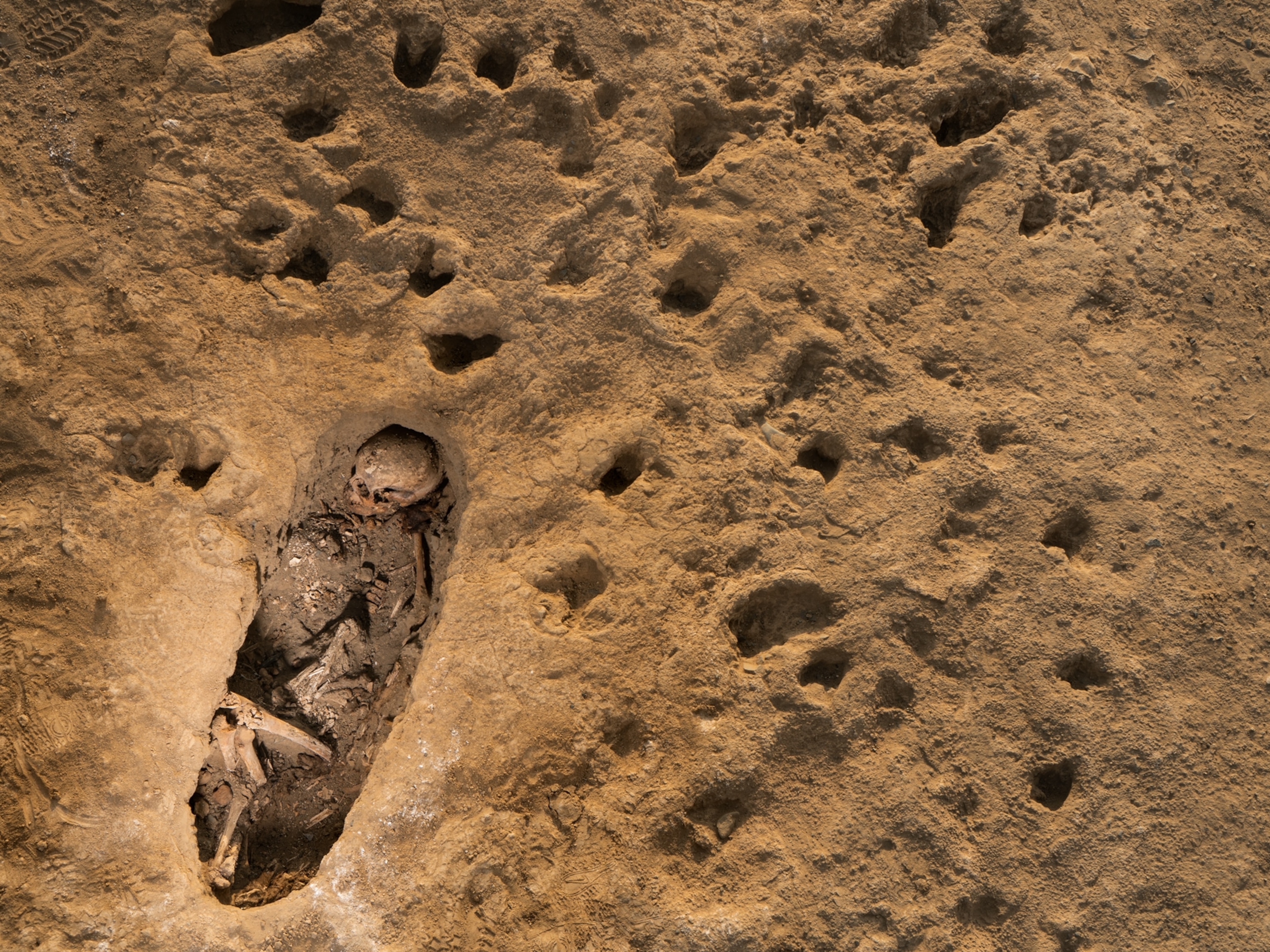He’s the most famous of Europe’s bog bodies. But who was Tollund Man?
Was he a human sacrifice? A criminal? Scientists are still piecing together details about the life—and death—of the man mummified in a Danish bog some 2,400 years ago.

When a family cutting peat for fuel unearthed a mysterious body in a Danish bog in 1950, they assumed the well-preserved corpse was a local murderer’s latest victim. In fact, he was anything but: Although the man had been killed, his body dated from the Iron Age about 2,400 years ago.
Now known only as the Tollund Man, his incredibly preserved face, stubbled and slightly smiling, has ensured him a place as one of the world’s most famous bog bodies—made even more mysterious by the fact he was the assumed victim of human sacrifice.
In the decades since his discovery, scientists have studied Tollund Man extensively and pieced together more details about his life and death. Here’s what to know about the naturally mummified man.
Who was Tollund Man?

The presence of wisdom teeth suggest the Tollund Man was at least 20 years old when he died in Denmark’s Bjældskovdal bog in Jutland, but researchers think he was actually between 30 and 40. Radiocarbon dating indicates he died at some point between 405 and 380 B.C.
(We thought we knew the secrets of Europe's bog bodies. We didn't.)
Standing at about 5 foot 3 inches, the Tollund Man was discovered in a sleeping position with a rope around his neck. An autopsy revealed he had died of hanging, noting his extremely well preserved head and face.
After his death, the acidity in the peat bog preserved Tollund Man’s bones and many of his soft tissues, including an intact yet shrunken brain and intestines complete with their contents. Tollund Man’s skin and nails had cured and blackened over thousands of years spent in the oxygen-free environment of the bog. But their full decomposition was blocked by the chemicals that are produced when sphagnum moss, the main moss that comprises peat, degrades.
Today, his body is preserved at the Silkeborg Museum, a Danish cultural heritage museum near the place of his discovery.
Who were his people?
Tollund Man lived during the early part of the Iron Age in the years before Rome conquered the majority of Europe. During the period, Jutland was well populated and home to villages and farms. The era’s farmers grew grain, kept animals, and engaged in religious rituals that involved leaving sacrifices—often food or weapons, but sometimes human bodies—in the local bogs.
Modern-day researchers suspect these bogs were seen as supernatural sites with connections to the gods and the afterlife. But since the Jutland dwellers left no writing behind, it’s unclear what actually drove their religious rituals.
(This ancient society tried to stop El Niño—with child sacrifice.)

What he wore
Bogs are famous for preserving clothing along with bodies, like the knitted clothing that surrounded a Scottish bog body found in 1951. But Tolland man wore much less apparel: He was buried naked, clad only in a cap and belt.
Further investigations have revealed that Tollund Man likely wore shoes for part of the year, but also walked barefoot much of the time. Stubble on his face indicates he must have shaved.
His last meal
In 2021, researchers discovered the contents of Tollund Man’s last meal—porridge containing barley, a variety of wild seeds, flax, and fish. The gut analysis also revealed that unlike some other famous bog bodies, Tollund Man wasn’t under the influence of edible hallucinogens or other medicinal plants when he died—signs that typically indicate a human sacrifice.
(Evidence shows these Inca child sacrifice victims were drugged.)
His death
But scientists say Tollund Man could have been the victim of a ritual sacrifice. The wide variety of types of seeds and weeds found in his gut are similar to those discovered in the digestive tracts of other bog bodies thought to have been sacrificed.
“People have suggested that they’re forming a human sacrifice because something’s going wrong in the environment,” archaeologist Henry Chapman said of those victims in a 2021 interview with National Geographic. Those cases have led researchers to believe that the sacrifices involved eating a wide variety of types of food before death, perhaps in response to environmental changes that threatened farming or food sources.
Another possibility is that Tollund Man’s death could have been more sinister: Perhaps he was a criminal or died by suicide, or was part of a vengeance killing thought to have been a practice in northern Europe at the time. Other bog bodies found throughout the region show evidence of purposeful killing and even gruesome abuses of the corpses.
(Reconstructing the face of the Bocksten Man, a 700-year-old murder victim.)
But though he was clearly killed on purpose, Tollund Man’s body was also carefully buried, and his mouth and eyes closed. Ultimately, that careful burial, his hanging, and the fact that cremation and grave burials were more common at the time than throwing bodies into bogs is why many researchers do believe his death was part of some kind of sacred sacrifice.
His remaining mysteries
Though it’s been nearly 75 years since his discovery, Tollund Man could continue to yield more information to curious archaeologists. During scientists’ initial experiments with the bog body, his head was carefully preserved and was put on display in Denmark. But his body dried out and was misplaced—yes, misplaced.
For decades no one knew where the bog body’s limbs and organs were. This led to a bizarre treasure hunt in the 1980s, when researchers armed with new technologies realized the potential worth of the rest of the body and asked for the public’s help locating the remainder of the corpse.
(Ötzi the Iceman: What we know 3 decades after his discovery.)


It turned out that the severed parts had been housed at a variety of museums and institutions throughout Denmark. The hunt yielded everything except for the internal organs and the bog body’s right big toe, whose location remained a mystery until the children of the former conservator returned it to the museum after their father’s death.
“Now nearly all body parts are in the museum[’]s possession,” the Silkeborg Museum says on its website. “Should anyone, however, come across a mysterious jar containing what might [be] his internal organs, we would be most interested to hear from you.”
These remains could still produce more insights, though researchers have so far been unsuccessful at obtaining ancient DNA from Tollund Man’s tissues.
In the meantime, the bog man has inspired everything from poems to music to children’s books—a testament to the ongoing fascination he invokes in both scientists and the public. “He is not merely a museum piece, but a man,” one archaeologist told The Age in 1956. “We refuse to believe in his death. There is a living man behind the warmth and fine humor of his face.”
Related Topics
You May Also Like
Go Further
Animals
- He’s called ‘omacha,’ a dolphin that transforms into a man. Why?He’s called ‘omacha,’ a dolphin that transforms into a man. Why?
- Behind the scenes at America’s biggest birding festivalBehind the scenes at America’s biggest birding festival
- How scientists are piecing together a sperm whale ‘alphabet’How scientists are piecing together a sperm whale ‘alphabet’
- Orangutan seen using plants to heal wound for first timeOrangutan seen using plants to heal wound for first time
Environment
- He’s called ‘omacha,’ a dolphin that transforms into a man. Why?He’s called ‘omacha,’ a dolphin that transforms into a man. Why?
- The northernmost flower living at the top of the worldThe northernmost flower living at the top of the world
- This beautiful floating flower is wreaking havoc on NigeriaThis beautiful floating flower is wreaking havoc on Nigeria
- What the Aral Sea might teach us about life after disasterWhat the Aral Sea might teach us about life after disaster
- What La Palma's 'lava tubes' tell us about life on other planetsWhat La Palma's 'lava tubes' tell us about life on other planets
History & Culture
- This thriving society vanished into thin air. What happened?This thriving society vanished into thin air. What happened?
- These were the real rules of courtship in the ‘Bridgerton’ eraThese were the real rules of courtship in the ‘Bridgerton’ era
Science
- Is the 5-second rule true? Science finally has an answer.
- Science
- Gory Details
Is the 5-second rule true? Science finally has an answer. - E-bikes are good for the environment—but what about your health?E-bikes are good for the environment—but what about your health?
- Why trigger points cause so much pain—and how you can relieve itWhy trigger points cause so much pain—and how you can relieve it
Travel
- The story of this French village is set in stone — literallyThe story of this French village is set in stone — literally
- How to spend a long weekend in Zagreb, Croatia
- Paid Content
How to spend a long weekend in Zagreb, Croatia - The best LGBTQ-friendly destinations for every travelerThe best LGBTQ-friendly destinations for every traveler






